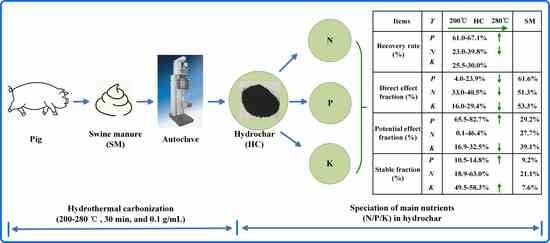Speciation of Main Nutrients (N/P/K) in Hydrochars Produced from the Hydrothermal Carbonization of Swine Manure under Different Reaction Temperatures
Abstract
:1. Introduction
2. Materials and Methods
2.1. Materials
2.2. HTC Experiments
2.3. Speciation Analysis of N/P/K
2.3.1. Speciation of Phosphorus (P)
2.3.2. Speciation of Nitrogen (N)
2.3.3. Speciation of Potassium (K)
2.4. Definition
3. Results and Discussions
3.1. Recovery Rate of N/P/K
3.2. Transformations of P Speciation
3.2.1. H2O-Extractable P (SP) and NaHCO3-Extractable P (EP)
3.2.2. NaOH-Extractable P (AP)
3.2.3. HCl-Extractable P (ISP) and Residual P (RP)
3.3. The Transformations of N Speciation
3.3.1. Inorganic Nitrogen (NH4-N and NO3-N)
3.3.2. Alkali-Hydrolyzed Organic Nitrogen (Alkali-ON)
3.3.3. Acid Hydrolyzed Organic Nitrogen (Acid-ON)
3.3.4. Residual Nitrogen (RN)
3.4. Transformations of K Speciation
3.4.1. H2O-Extractable K (SK) and Ammonium Acetate-Extractable K (EK)
3.4.2. HNO3-Extractable Potassium (SRK) and Organic-Bound Potassium (OBK)
3.4.3. Residual Potassium (RK)
3.5. Prospects
4. Conclusions
Author Contributions
Funding
Institutional Review Board Statement
Informed Consent Statement
Data Availability Statement
Conflicts of Interest
References
- Schommer, V.A.; Wenzel, B.M.; Daroit, D.J. Anaerobic co-digestion of swine manure and chicken feathers: Effects of manure maturation and microbial pretreatment of feathers on methane production. Renew. Energy 2020, 152, 1284–1291. [Google Scholar] [CrossRef]
- Lin, J.C.; Mariuzza, D.; Volpe, M.; Fiori, L.; Ceylan, S.; Goldfarb, J.L. Integrated thermochemical conversion process for valorizing mixed agricultural and dairy waste to nutrient-enriched biochars and biofuels. Bioresour. Technol. 2021, 328, 124765. [Google Scholar] [CrossRef]
- Duan, N.; Khoshnevisan, B.; Lin, C.; Liu, Z.; Liu, H. Life cycle assessment of anaerobic digestion of pig manure coupled with different digestate treatment technologies. Environ. Int. 2020, 137, 105522. [Google Scholar] [CrossRef]
- Song, C.; Yuan, W.; Shan, S.; Ma, Q.; Zhang, H.; Wang, X.; Niazi, N.K.; Wang, H. Changes of nutrients and potentially toxic elements during hydrothermal carbonization of pig manure. Chemosphere 2020, 243, 125331. [Google Scholar] [CrossRef] [PubMed]
- Awasthi, M.K.; Duan, Y.; Liu, T.; Awasthi, S.K.; Zhang, Z. Relevance of biochar to influence the bacterial succession during pig manure composting. Bioresour. Technol. 2020, 304, 122962. [Google Scholar] [CrossRef]
- Zhu, F.; Hong, C.; Wang, W.; Lyu, H.; Zhu, W.; Xv, H.; Yao, Y. A microbial agent effectively reduces ammonia volatilization and ensures good maggot yield from pig manure composted via housefly larvae cultivation. J. Clean. Prod. 2020, 270, 122373. [Google Scholar] [CrossRef]
- Wang, Y.; Zhang, J.; Li, Y.; Jia, S.; Song, Y.; Sun, Y.; Zheng, Z.H.; Yu, J.D.; Cui, Z.J.; Han, Y.Y.; et al. Methane production from the co-digestion of pig manure and corn stover with the addition of cucumber residue: Role of the total solids content and feedstock-to-inoculum ratio. Bioresour. Technol. 2020, 306, 123172. [Google Scholar] [CrossRef]
- Ramírez-Islas, M.E.; Güereca, L.P.; Sosa-Rodriguez, F.S.; Cobos-Peralta, M.A. Environmental assessment of energy production from anaerobic digestion of pig manure at medium-scale using life cycle assessment. Waste Manag. 2020, 102, 85–96. [Google Scholar] [CrossRef]
- Song, C.; Shan, S.; Yang, C.; Zhang, C.; Zhou, X.; Ma, Q.; Kim, Y.; Zheng, H.B.; Cao, Y.C. The comparison of dissolved organic matter in hydrochars and biochars from pig manure. Sci. Total Environ. 2020, 720, 137423. [Google Scholar] [CrossRef]
- Lang, Q.; Chen, M.; Guo, Y.; Liu, Z.; Gai, C. Effect of hydrothermal carbonization on heavy metals in swine manure: Speciation, bioavailability and environmental risk. J. Environ. Manag. 2019, 234, 97–103. [Google Scholar] [CrossRef]
- Zhou, C.H.; Huang, H.J.; Li, L.; Pan, Z.Q.; Xiao, X.F.; Wang, J.X. Advances in Hydrothermal Carbonization of Livestock Manure. In Sustainable Green Chemical Processes and Their Allied Applications; Nanotechnology in the Life Sciences; Inamuddin, M., Asiri, A.M., Eds.; Springer: Cham, Switzerland, 2020; pp. 183–205. [Google Scholar] [CrossRef]
- Lee, D.J.; Jeong, K.H.; Lee, D.H.; Lee, S.H.; Jung, M.W.; Jang, Y.N.; Jo, G.G.; Kwag, J.H.; Yi, H.; Park, Y.K.; et al. Catalytic pyrolysis of swine manure using CO2 and steel slag. Environ. Int. 2019, 133, 105204. [Google Scholar] [CrossRef]
- Li, F.; Wu, X.; Ji, W.; Gui, X.; Chen, Y.; Zhao, J.; Zhou, C.H.; Ren, T.B. Effects of pyrolysis temperature on properties of swine manure biochar and its environmental risks of heavy metals. J. Anal. Appl. Pyrolysis 2020, 152, 104945. [Google Scholar] [CrossRef]
- Adánez-Rubio, I.; Ferreira, R.; Rio, T.; Alzueta, M.U.; Costa, M. Soot and char formation in the gasification of pig manure in a drop tube reactor. Fuel 2020, 281, 118738. [Google Scholar] [CrossRef]
- Fernandez-Lopez, M.; López-González, D.; Puig-Gamero, M.; Valverde, J.L.; Sanchez- Silva, L. CO2 gasification of dairy and swine manure: A life cycle assessment approach. Renew. Energy 2016, 95, 552–560. [Google Scholar] [CrossRef]
- Lu, J.; Watson, J.; Zeng, J.; Li, H.; Zhu, Z.; Wang, M.; Zhang, Y.H.; Liu, Z.D. Biocrude production and heavy metal migration during hydrothermal liquefaction of swine manure. Process Saf. Environ. 2018, 115, 108–115. [Google Scholar] [CrossRef]
- Wu, Q.; Wang, H.; Zheng, X.; Liu, F.; Wang, A.; Zou, D.; Yuan, J.R.; Xiao, Z.H. Thermochemical liquefaction of pig manure: Factors influencing on oil. Fuel 2020, 264, 116884. [Google Scholar] [CrossRef]
- Shen, Y. A review on hydrothermal carbonization of biomass and plastic wastes to energy products. Biomass Bioenergy 2020, 134, 105479. [Google Scholar] [CrossRef]
- Sharma, H.B.; Sarmah, A.K.; Dubey, B. Hydrothermal carbonization of renewable waste biomass for solid biofuel production: A discussion on process mechanism, the influence of process parameters, environmental performance and fuel properties of hydrochar. Renew. Sustain. Energy Rev. 2020, 123, 109761. [Google Scholar] [CrossRef]
- Lucian, M.; Volpe, M.; Fiori, L. Hydrothermal Carbonization Kinetics of Lignocellulosic Agro-Wastes: Experimental Data and Modeling. Energies 2019, 12, 516. [Google Scholar] [CrossRef] [Green Version]
- Wang, J.X.; Chen, S.W.; Lai, F.Y.; Liu, S.Y.; Xiong, J.B.; Zhou, C.F.; Yu, Y.; Huang, H.J. Microwave-assisted hydrothermal carbonization of pig feces for the production of hydrochar. J. Supercrit. Fluids 2020, 162, 104858. [Google Scholar] [CrossRef]
- Xiong, J.B.; Pan, Z.Q.; Xiao, X.F.; Huang, H.J.; Lai, F.Y.; Wang, J.X.; Chen, S.W. Study on the hydrothermal carbonization of swine manure: The effect of process parameters on the yield/properties of hydrochar and process water. J. Anal. Appl. Pyrolysis 2019, 144, 104692. [Google Scholar] [CrossRef]
- Song, C.; Shan, S.; Müller, K.; Wu, S.; Niazi, N.K.; Xu, S.; Shen, Y.; Rinklebe, J.; Liu, D.; Wang, H. Characterization of pig manure-derived hydrochars for their potential application as fertilizer. Environ. Sci. Pollut. Res. 2018, 25, 25772. [Google Scholar] [CrossRef] [PubMed]
- Lang, Q.; Zhang, B.; Liu, Z.; Jiao, W.; Xia, Y.; Chen, Z.; Li, D.; Ma, J.; Gai, C. Properties of hydrochars derived from swine manure by CaO assisted hydrothermal carbonization. J. Environ. Manag. 2019, 233, 440–446. [Google Scholar] [CrossRef]
- Ro, K.S.; Flora, J.R.V.; Bae, S.Y.; Libra, J.A.; Berge, N.D.; Álvarez-Murillo, A.; Li, L. Properties of animal-manure-based hydrochars and predictions using published models. ACS Sustain. Chem. Eng. 2017, 5, 7317–7324. [Google Scholar] [CrossRef]
- Lang, Q.; Zhang, B.; Liu, Z.; Chen, Z.; Xia, Y.; Li, D.; Ma, J.; Gai, C. Co-hydrothermal carbonization of corn stalk and swine manure: Combustion behavior of hydrochar by thermogravimetric analysis. Bioresour. Technol. 2019, 271, 75–83. [Google Scholar] [CrossRef]
- Lang, Q.; Guo, Y.; Zheng, Q.; Liu, Z.; Gai, C. Co-hydrothermal carbonization of lignocellulosic biomass and swine manure: Hydrochar properties and heavy metal transformation behavior. Bioresour. Technol. 2018, 266, 242–248. [Google Scholar] [CrossRef] [PubMed]
- Lang, Q.; Luo, H.; Li, Y.; Li, D.; Liu, Z.; Yang, T. Thermal behavior of hydrochar from co-hydrothermal carbonization of swine manure and sawdust: Effect of process water recirculation. Sustain. Energy Fuels 2019, 3, 2329–2336. [Google Scholar] [CrossRef]
- Lang, Q.; Zhang, B.; Li, Y.; Liu, Z.; Jiao, W. Formation and toxicity of polycyclic aromatic hydrocarbons during CaO assisted hydrothermal carbonization of swine manure. Waste Manag. 2019, 100, 84–90. [Google Scholar] [CrossRef] [PubMed]
- Jin, H.; Yan, D.; Zhu, N.; Zhang, S.; Zheng, M. Immobilization of metal(loid)s in hydrochars produced from digested swine and dairy manures. Waste Manag. 2019, 88, 10–20. [Google Scholar] [CrossRef]
- Gascó, G.; Paz-Ferreiro, J.; Álvarez, M.L.; Saa, A.; Méndez, A. Biochars and hydrochars prepared by pyrolysis and hydrothermal carbonisation of pig manure. Waste Manag. 2018, 79, 395–403. [Google Scholar] [CrossRef]
- Liu, Y.; Yao, S.; Wang, Y.; Lu, H.; Brar, S.K.; Yang, S. Bio- and hydrochars from rice straw and pig manure: Inter-comparison. Bioresour. Technol. 2017, 235, 332–337. [Google Scholar] [CrossRef] [Green Version]
- Cao, X.; Ro, K.S.; Chappell, M.; Li, Y.; Mao, J. Chemical structures of swine-manure chars produced under different carbonization conditions investigated by advanced solid-state 13C nuclear magnetic resonance (NMR) spectroscopy. Energy Fuels 2011, 25, 388–397. [Google Scholar] [CrossRef]
- Huang, R.; Fang, C.; Zhang, B.; Tang, Y. Transformations of phosphorus speciation during (hydro)thermal treatments of animal manures. Environ. Sci. Technol. 2018, 52, 3016–3026. [Google Scholar] [CrossRef]
- Ekpo, U.; Ross, A.B.; Camargo-Valero, M.A.; Fletcher, L.A. Fletcher, Influence of pH on hydrothermal treatment of swine manure: Impact on extraction of nitrogen and phosphorus in process water. Bioresour. Technol. 2016, 214, 637–644. [Google Scholar] [CrossRef]
- Huang, R.; Fang, C.; Lu, X.; Jiang, R.; Tang, Y. Transformation of phosphorus during (hydro)thermal treatments of solid biowastes: Reaction mechanisms and implications for P reclamation and recycling. Environ. Sci. Technol. 2017, 51, 10284–10298. [Google Scholar] [CrossRef] [PubMed]
- Qaramaleki, S.V.; Villamil, J.A.; Mohedano, A.F.; Coronella, C.J. Factors affecting solubilization of phosphorus and nitrogen through hydrothermal carbonization of animal manure. ACS Sustain. Chem. Eng. 2020, 8, 12462–12470. [Google Scholar] [CrossRef]
- Pansu, M.; Gautheyrou, J. (Eds.) Organic Forms of Nitrogen, Mineralizable Nitrogen (and Carbon). In Handbook of Soil Analysis: Mineralogical, Organic and Inorganic Methods; Springer: Berlin/Heidelberg, Germany, 2006; pp. 497–547. [Google Scholar] [CrossRef]
- Andrist-Rangel, Y.; Simonsson, M.; Andersson, S.; Öborn, I.; Hillier, S. Mineralogical budgeting of potassium in soil: A basis for understanding standard measures of reserve potassium. J. Plant Nutr. Soil Sci. 2006, 169, 605–615. [Google Scholar] [CrossRef]
- Soil Agrochemical Analysis; Bao, S.D. (Ed.) China Agricultural Publishing House: Beijing, China, 2000; pp. 99–114. [Google Scholar]
- Li, J.; Niu, L.; Zhang, Q.; Di, H.; Hao, J. Impacts of long-term lack of potassium fertilization on different forms of soil potassium and crop yields on the North China Plains. J. Soils Sediments 2017, 17, 1607–1617. [Google Scholar] [CrossRef]
- Zhang, S.; Zhang, X.; Liu, X.; Liu, W.; Liu, Z. Spatial distribution of soil nutrient at depth in black soil of Northeast China: A case study of soil available potassium. Nutr. Cycl. Agroecosystems 2013, 95, 319–331. [Google Scholar] [CrossRef]
- Alhnidi, M.J.; Wüst, D.; Funke, A.; Hang, L.; Kruse, A. Fate of nitrogen, phosphate, and potassium during hydrothermal carbonization and the potential for nutrient recovery. ACS Sustain. Chem. Eng. 2020, 8, 15507–15516. [Google Scholar] [CrossRef]
- Belete, Y.Z.; Mau, V.; Yahav Spitzer, R.; Posmanik, R.; Jassby, D.; Iddya, A.; Kassem, N.; Tester, J.W.; Gross, A. Hydrothermal carbonization of anaerobic digestate and manure from a dairy farm on energy recovery and the fate of nutrients. Bioresour. Technol. 2021, 333, 125164. [Google Scholar] [CrossRef] [PubMed]
- Huang, R.; Tang, Y. Evolution of phosphorus complexation and mineralogy during (hydro)thermal treatments of activated and anaerobically digested sludge: Insights from sequential extraction and P K-edge XANES. Water Res. 2016, 100, 439–447. [Google Scholar] [CrossRef] [Green Version]
- Funke, A. Fate of plant available nutrients during hydrothermal carbonization of digestate. Chem. Ing. Tech. 2015, 87, 1713–1719. [Google Scholar] [CrossRef]
- Pagliari, P.; Laboski, C. Dairy manure treatment effects on manure phosphorus fractionation and changes in soil test phosphorus. Biol. Fertil. Soils 2013, 49, 987–999. [Google Scholar] [CrossRef]
- Pagliari, P.H. Variety and solubility of phosphorus forms in animal manure and their effects on soil test phosphorus. In Applied Manure and Nutrient Chemistry for Sustainable Agriculture and Environment; He, Z., Zhang, H., Eds.; Springer: Dordrecht, The Netherlands, 2014; pp. 141–161. [Google Scholar] [CrossRef]
- Ghanim, B.M.; Kwapinski, W.; Leahy, J.J. Speciation of nutrients in hydrochar produced from hydrothermal carbonization of poultry litter under different treatment conditions. ACS Sustain. Chem. Eng. 2018, 6, 11265–11272. [Google Scholar] [CrossRef]
- Dai, L.; Tan, F.; Wu, B.; He, M.; Wang, W.; Tang, X.; Hu, Q.H.; Zhang, M. Immobilization of phosphorus in cow manure during hydrothermal carbonization. J. Environ. Manag. 2015, 157, 49–53. [Google Scholar] [CrossRef] [PubMed]
- Pardo, P.; López-Sánchez, J.F.; Rauret, G. Relationships between phosphorus fractionation and major components in sediments using the SMT harmonised extraction procedure. Anal. Bioanal. Chem. 2003, 376, 248–254. [Google Scholar] [CrossRef]
- Whalen, J.K.; Chang, C. Phosphorus accumulation in cultivated soils from long-term annual applications of cattle feedlot manure. J. Environ. Qual. 2001, 30, 229–237. [Google Scholar] [CrossRef] [PubMed]
- Zhao, P.; Chen, H.; Ge, S.; Yoshikawa, K. Effect of the hydrothermal pretreatment for the reduction of NO emission from sewage sludge combustion. Appl. Energy 2013, 111, 199–205. [Google Scholar] [CrossRef]
- Kruse, A.; Koch, F.; Stelzl, K.; Wüst, D.; Zeller, M. Fate of nitrogen during hydrothermal carbonization. Energy Fuel 2016, 30, 8037–8042. [Google Scholar] [CrossRef]
- Regmi, P.; Garcia-Moscoso, J.L.; Kumar, S.; Cao, X.; Mao, J.; Schafran, G. Removal of copper and cadmium from aqueous solution using switchgrass biochar produced via hydrothermal carbonization process. J. Environ. Manag. 2012, 109, 61–69. [Google Scholar] [CrossRef]
- Ferrentino, R.; Ceccato, R.; Marchetti, V.; Andreottola, G.; Fiori, L. Sewage sludge hydrochar: An option for removal of methylene blue from wastewater. Appl. Sci. 2020, 10, 3445. [Google Scholar] [CrossRef]
- Wang, T.; Zhai, Y.; Zhu, Y.; Peng, C.; Xu, B.; Wang, T.; Li, C.T.; Zeng, G.M. Influence of temperature on nitrogen fate during hydrothermal carbonization of food waste. Bioresour. Technol. 2018, 247, 182–189. [Google Scholar] [CrossRef]
- Wu, K.; Zhang, X.; Yuan, Q. Effects of process parameters on the distribution characteristics of inorganic nutrients from hydrothermal carbonization of cattle manure. J. Environ. Manag. 2018, 209, 328–335. [Google Scholar] [CrossRef]
- Zhu, G.Y.; Zhu, X.; Xiao, Z.B.; Zhou, R.J.; Feng, N.N.; Niu, Y.W. A review of amino acids extraction from animal waste biomass and reducing sugars extraction from plant waste biomass by a clean method. Biomass Convers. Biorefinery 2015, 5, 309–320. [Google Scholar] [CrossRef]
- Oliver-Tomas, B.; Hitzl, M.; Owsianiak, M.; Renz, M. Evaluation of hydrothermal carbonization in urban mining for the recovery of phosphorus from the organic fraction of municipal solid waste. Resour. Conserv. Recycl. 2019, 147, 111–118. [Google Scholar] [CrossRef]
- Falco, C.; Sevilla, M.; White, R.J.; Rothe, R.; Titirici, M.M. Renewable nitrogen-doped hydrothermal carbons derived from microalgae. ChemSusChem 2012, 5, 1834–1840. [Google Scholar] [CrossRef] [Green Version]
- Aragón-Briceño, C.I.; Pozarlik, A.K.; Bramer, E.A.; Niedzwiecki, L.; Pawlak-Kruczek, H.; Brem, G. Hydrothermal carbonization of wet biomass from nitrogen and phosphorus approach: A review. Renew. Energy 2021, 171, 401–415. [Google Scholar] [CrossRef]
- Funke, A.; Mumme, J.; Koon, M.; Diakité, M. Cascaded production of biogas and hydrochar from wheat straw: Energetic potential and recovery of carbon and plant nutrients. Biomass Bioenergy 2013, 58, 229–237. [Google Scholar] [CrossRef]
- Wang, L.; Chang, Y.; Liu, Q. Fate and distribution of nutrients and heavy metals during hydrothermal carbonization of sewage sludge with implication to land application. J. Clean. Prod. 2019, 225, 972–983. [Google Scholar] [CrossRef]
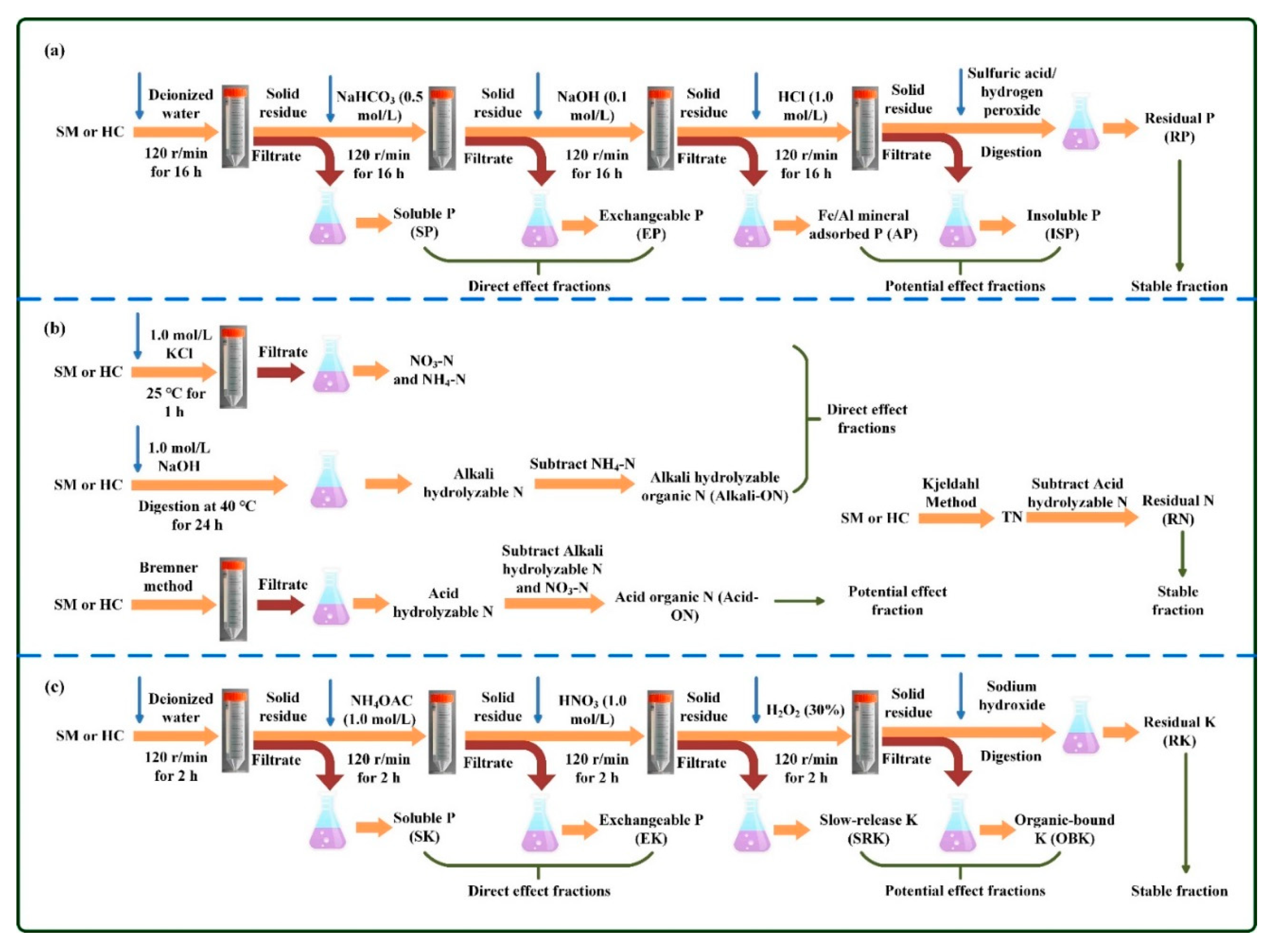
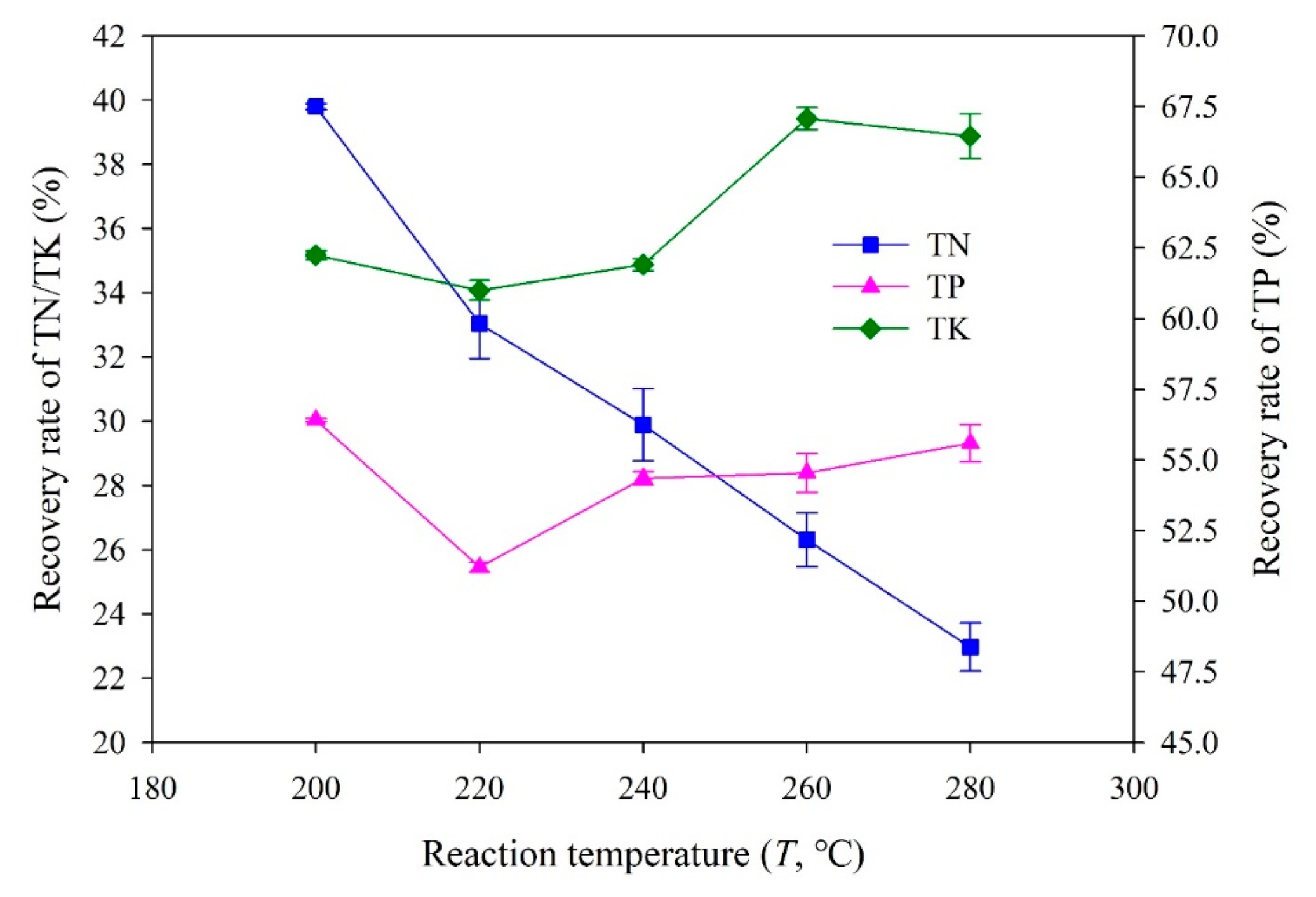
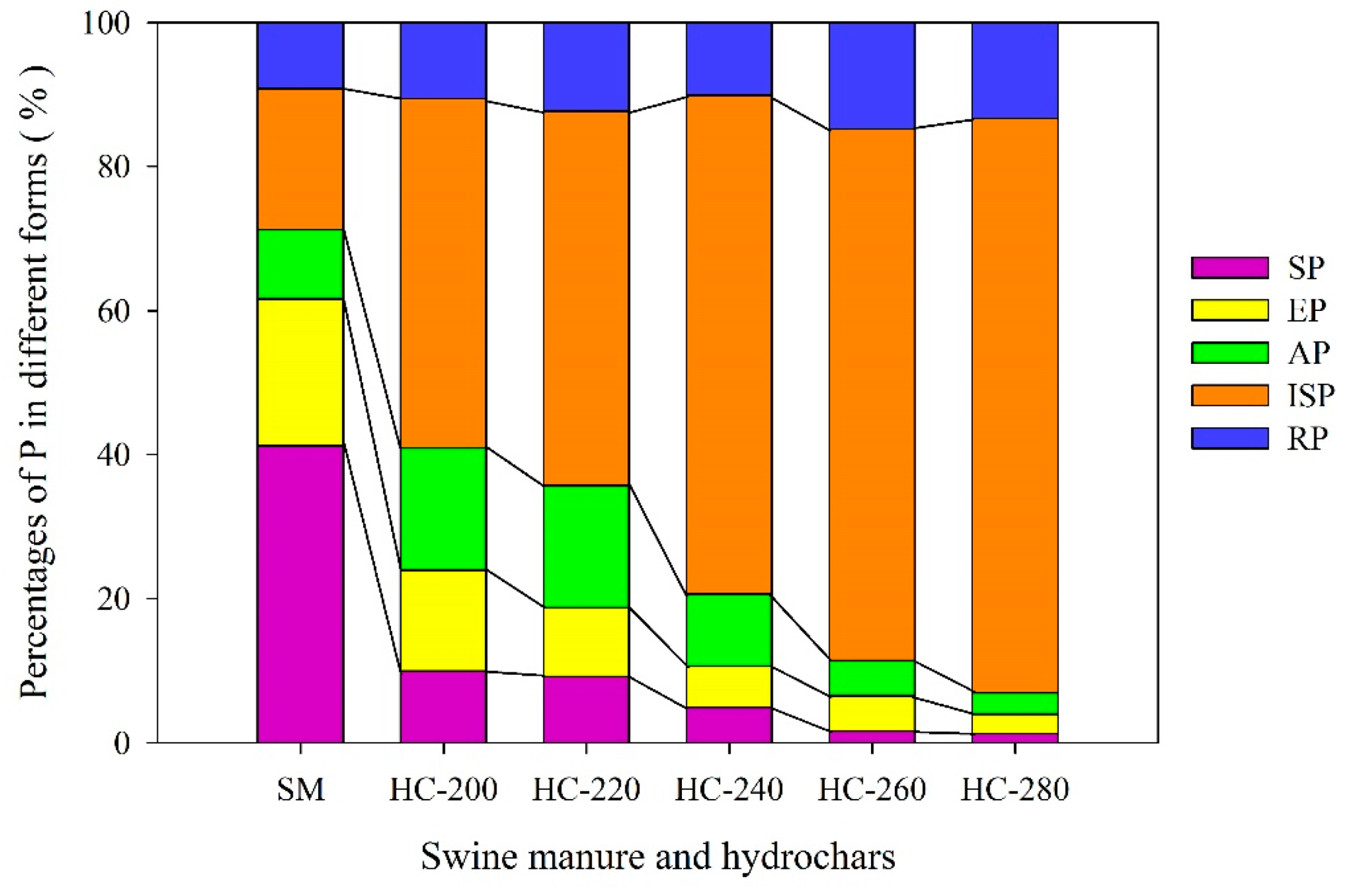
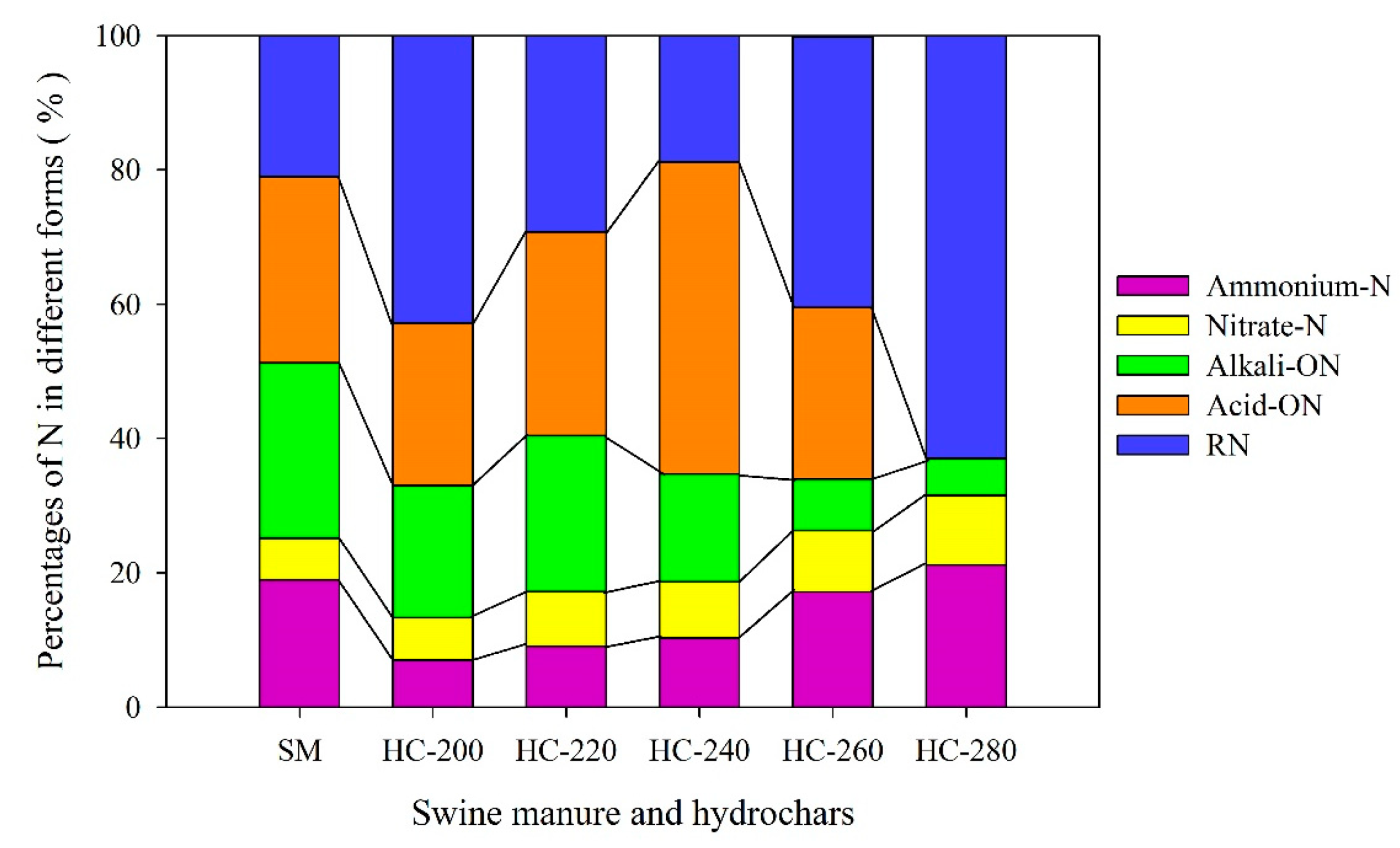

| Items | Concentrations (mg/g, Dry Basis) | |||||
|---|---|---|---|---|---|---|
| Ca | Mg | Fe | Mn | Al | Na | |
| SM | 17.16 ± 0.25 | 7.88 ± 0.08 | 6.93 ± 0.51 | 0.63 ± 0.02 | 5.96 ± 0.33 | 4.52 ± 0.34 |
| Sample | SP | EP | AP | ISP | RP | ∑ (TP) |
|---|---|---|---|---|---|---|
| SM | 10.66 ± 0.07 | 5.27 ± 0.06 | 2.49 ± 0.03 | 5.06 ± 0.04 | 2.38 ± 0.15 | 25.86 ± 0.35 |
| HC-200 | 2.73 ± 0.01 | 3.83 ± 0.02 | 4.67 ± 0.25 | 13.29 ± 0.08 | 2.89 ± 0.07 | 27.41 ± 0.44 |
| HC-220 | 2.62 ± 0.01 | 2.70 ± 0.01 | 4.83 ± 0.13 | 14.77 ± 0.02 | 3.49 ± 0.05 | 28.41 ± 0.22 |
| HC-240 | 1.47 ± 0.02 | 1.74 ± 0.03 | 3.01 ± 0.05 | 20.83 ± 0.04 | 3.05 ± 0.16 | 30.10 ± 0.30 |
| HC-260 | 0.52 ± 0.02 | 1.61 ± 0.01 | 1.59 ± 0.02 | 24.08 ± 0.45 | 4.83 ± 0.13 | 32.63 ± 0.63 |
| HC-280 | 0.44 ± 0.04 | 0.92 ± 0.01 | 1.01 ± 0.02 | 27.29 ± 0.52 | 4.56 ± 0.28 | 34.22 ± 0.87 |
| Sample | NH4-N | NO3-N | Alkali-ON | Acid-ON | RN | ∑ (TN) |
|---|---|---|---|---|---|---|
| SM | 4.48 ± 0.03 | 1.47 ± 0.06 | 6.19 ± 0.04 | 6.55 ± 0.26 | 4.99 ± 0.03 | 23.68 ± 1.04 |
| HC-200 | 1.12 ± 0.02 | 1.02 ± 0.04 | 3.16 ± 0.06 | 3.87 ± 0.11 | 6.87 ± 0.12 | 16.05 ± 0.67 |
| HC-220 | 1.28 ± 0.02 | 1.14 ± 0.03 | 3.28 ± 0.13 | 4.27 ± 0.16 | 4.12 ± 0.05 | 14.09 ± 0.16 |
| HC-240 | 1.37 ± 0.11 | 1.11 ± 0.07 | 2.14 ± 0.15 | 6.18 ± 0.09 | 2.51 ± 0.04 | 13.31 ± 0.08 |
| HC-260 | 2.01 ± 0.08 | 1.07 ± 0.12 | 0.90 ± 0.04 | 2.99 ± 0.07 | 4.73 ± 0.06 | 11.72 ± 0.14 |
| HC-280 | 2.29 ± 0.07 | 1.13 ± 0.05 | 0.58 ± 0.03 | 0.01 ± 0.05 | 6.82 ± 0.15 | 10.83 ± 0.12 |
| Sample | SK | EK | SRK | OBK | RK | ∑ (TK) |
|---|---|---|---|---|---|---|
| SM | 4.94 ± 0.06 | 2.88 ± 0.14 | 3.61 ± 0.32 | 2.13 ± 0.13 | 1.12 ± 0.07 | 14.68 ± 0.72 |
| HC-200 | 0.26 ± 0.02 | 0.94 ± 0.05 | 1.97 ± 0.08 | 0.47 ± 0.01 | 3.87 ± 0.23 | 7.51 ± 0.38 |
| HC-220 | 0.95 ± 0.03 | 1.03 ± 0.03 | 0.96 ± 0.05 | 0.49 ± 0.02 | 3.33 ± 0.16 | 6.73 ± 0.29 |
| HC-240 | 1.11 ± 0.01 | 0.82 ± 0.01 | 0.83 ± 0.04 | 0.49 ± 0.01 | 4.54 ± 0.37 | 7.79 ± 0.44 |
| HC-260 | 1.13 ± 0.07 | 0.74 ± 0.02 | 1.23 ± 0.02 | 0.49 ± 0.02 | 4.25 ± 0.42 | 7.84 ± 0.55 |
| HC-280 | 1.27 ± 0.06 | 0.51 ± 0.01 | 1.82 ± 0.11 | 0.48 ± 0.03 | 4.49 ± 0.38 | 8.57 ± 0.59 |
Publisher’s Note: MDPI stays neutral with regard to jurisdictional claims in published maps and institutional affiliations. |
© 2021 by the authors. Licensee MDPI, Basel, Switzerland. This article is an open access article distributed under the terms and conditions of the Creative Commons Attribution (CC BY) license (https://creativecommons.org/licenses/by/4.0/).
Share and Cite
Xiong, J.; Chen, S.; Wang, J.; Wang, Y.; Fang, X.; Huang, H. Speciation of Main Nutrients (N/P/K) in Hydrochars Produced from the Hydrothermal Carbonization of Swine Manure under Different Reaction Temperatures. Materials 2021, 14, 4114. https://doi.org/10.3390/ma14154114
Xiong J, Chen S, Wang J, Wang Y, Fang X, Huang H. Speciation of Main Nutrients (N/P/K) in Hydrochars Produced from the Hydrothermal Carbonization of Swine Manure under Different Reaction Temperatures. Materials. 2021; 14(15):4114. https://doi.org/10.3390/ma14154114
Chicago/Turabian StyleXiong, Jiangbo, Shuaiwei Chen, Jiaxin Wang, Yujie Wang, Xiaolin Fang, and Huajun Huang. 2021. "Speciation of Main Nutrients (N/P/K) in Hydrochars Produced from the Hydrothermal Carbonization of Swine Manure under Different Reaction Temperatures" Materials 14, no. 15: 4114. https://doi.org/10.3390/ma14154114
APA StyleXiong, J., Chen, S., Wang, J., Wang, Y., Fang, X., & Huang, H. (2021). Speciation of Main Nutrients (N/P/K) in Hydrochars Produced from the Hydrothermal Carbonization of Swine Manure under Different Reaction Temperatures. Materials, 14(15), 4114. https://doi.org/10.3390/ma14154114






